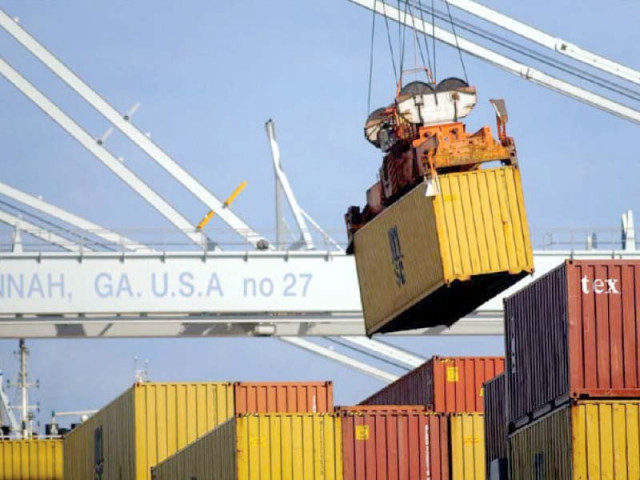Pakistan loses $1.6b on low exports
Import restrictions not a solution to external sector challenges, says ministry

The Ministry of Planning on Friday disagreed with the policy of restricting imports to control the yawning current account deficit, emphasising that focus should instead be on exports that got vital support from a surge in global commodity prices.
In its first quarterly economic review report, the planning ministry revealed that in terms of quantity, Pakistan’s exports were going down and the country sustained a loss of $1.6 billion in the July-September quarter of current fiscal year.
Not only that, the surge in global commodity prices also led to a $3 billion increase in exports, which was equal to 42% of total exports during the period, according to the report that carried some high quality analysis.
Had there been no surge in global prices, Pakistan’s exports would have plunged in dollars terms in the first quarter of FY22.
“Quantity exported of cotton cloth went down substantially and only the global price surge saved the day for exports of textiles in dollar terms,” said the report.
It cited Pakistan Bureau of Statistics (PBS) figures, showing that cotton cloth exports went down 75% in quantity terms that led to a potential loss of $1.7 billion.
The revelation should be seen as a huge setback to the claims made by Commerce Adviser Abdul Razak Dawood and the textile lobby - All Pakistan Textile Mills Association (Aptma) - about a massive increase in exports.
Exporters have failed the nation and the government despite getting the benefit of low taxes and cheaper energy prices.
The report underlined that imports surged again to their highest-ever level at $17.5 billion and recorded a 64.3% growth in the first quarter of current fiscal year to cater to needs of growing economic activities in the country.
The report also challenged the policy stance taken by the State Bank of Pakistan (SBP) and the Ministry of Finance to address the issue of current account deficit that had widened to $5.1 billion in first four months of FY22.
The four-month deficit was about 100% more than the annual target of $2.3 billion.
“A broad-based policy thrust is needed to focus on increase in exports rather than curtailing imports,” said the Ministry for Planning and Development.
“The momentum in imports is especially endangering the prospects of macroeconomic stability and the existing momentum in exports along with heightened remittance inflows are partially offsetting the growing trade imbalances and debt servicing burden,” it added.
The report pointed out that Pakistan needed to make $21.8 billion worth of foreign debt-related payments in the current fiscal year, out of which public sector liability was $17.7 billion.
For the next fiscal year, the foreign debt servicing liability was estimated at $17.2 billion, stated the planning ministry.
While citing historical data, the ministry stated that Pakistan’s economy had a strong correlation between increase in economic activity and surge in imports. Global commodity prices and import growth have moved in tandem from January 2000 to September 2021.
The post-pandemic pickup in economic activity has once again fueled import demand and an imperative to preempt any balance of payments crisis in the near term.
It highlighted that the central bank had taken two major policy decisions - enhancing the cash margin requirement for 500-plus items and the market-determined exchange rate policy.
“Real Effective Exchange rate (REER) has historically shown ineffectiveness to curb imports in the past. Import substitution strategy has also failed in the past. Cash margin requirement was used in 2008 as well but was unable to make significant contribution to bridle imports,” said the Ministry of Planning.
The views expressed by the ministry are similar to those of the World Bank that has also discounted import-related restrictions as a reasonable policy to stem a serious balance of payments crisis.
The ministry said that global commodity prices were correlated with import growth primarily because Pakistan’s imports were relatively inelastic and the bulk of import basket consisted of essential items.
Food, consumer goods (mobiles and vehicles) and textile-related imports have touched their highest-ever share while energy imports have their lowest share in the past two decades.
“One lesson can be drawn which is that four-fifths of imports are essentials and could not be avoided.”
During the previous fiscal year, food imports were equal to 13.4% of total imports, other consumer goods 8.7%, intermediary primary goods 3.4%, intermediate manufactured goods 14%, petroleum and other energy-related imports 18%, capital goods and other machinery 10.3% and textile goods 10.4%.
While commenting on the economic outlook of Pakistan, the planning ministry said that the economic stimulus package announced by the government had helped in the revival of manufacturing sector. However, the pace of the recovery is still hindered by supply chain glitches at the local and global level.
Published in The Express Tribune, November 27th, 2021.
Like Business on Facebook, follow @TribuneBiz on Twitter to stay informed and join in the conversation.


















COMMENTS
Comments are moderated and generally will be posted if they are on-topic and not abusive.
For more information, please see our Comments FAQ